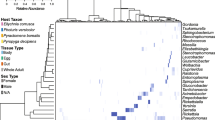Abstract
Cosmopolitan species of cellular slime molds occur continents apart in both tropical and temperate zones of the world though the spore masses are too heavy to be wind borne, and water dispersal is limited to the watercourses. A highly mobile distribution vector was found in ground-feeding migratory song birds. Nine ubiquitous species and 2 ecologicially distinct species of dictyostelid cellular slime molds were isolated from the feces of ground-feeding eastern North American migratory thrushes, finches, sparrows and warblers, both on breeding and winter grounds. Three propagules of slime molds, amoebae, spores and macrocysts survive passage through the avian digesive tract and remain in the gut long enough to be transported by major bird migrations. Habitats with the greates species diversity of both cellular slime molds and ground-feeding passerines concur in both eastern North America and Central America. Birds actively seek their prefered habitats; the cellular slime molds have arrived at these habitats as passengers. Rare slime molds can serve as a marker to the habitats that migratory birds have visited, or birds with known habitats can provide clues as to the distribution of rare species of cellular slime molds.
Similar content being viewed by others
References
Atkinson KM (1971) Further experiments in dispersal of phytoplankton by birds. Wildfowl 22:98–99
Cavender JC (1969) The occurrence and distribution of Acrasieae in forest soils. I. Europe. II. East Africa. Amer J Bot 56:989–998
Cavender JC (1973) Geographical distribution of acrasieae. Mycologia LXV:1044–1054
Cavender JC (1976) Cellular slime molds of Southeast Asia. I. Description of new species. II. Occurence and distribution. Am J Bot 63:60–73
Cavender JC (1978) Cellular slime molds in tundra and forest soils of Alaska including a new species, Dictyostelium septentrionalis. Can J Bot 56:1326–1332
Cavender JC (1982) Cellular slime molds of Ohio USA. Ohio J Sci 82: Abstract 10
Cavender JC, Raper KB (1965a) The acrasieae in nature. I. Isolation. Amer J Bot 52:294–296
Cavender JC, Raper KB (1965b) The acrasieae in nature. III. Occurence and distribution in forests of eastern North America. Amer J Bot 52:302–308
Cavender JC, Raper KB (1968) The occurance and distribution of acrasieae in forests of subtropical and tropical America. Amer J Bot 55:504–513
Cotter DA, Raper KB (1968) Spore germination in strains of Dictyostelium discoideum and other members of the Dictyosteliaceae. J Bact 96:1690–1695
Davison GWH (1976) The role of birds in moss dispersal. Brit Birds 69:65–66
Hagiwara H (1978) The Acrasiales in Japan IV. Bull Nat Sci Mus Ser B (Tokyo) 4:27–32
Hagiwara H (1982) Altitudinal distribution of Dictyostelid cellular slime molds in the Gosainkund region of Nepal. Reports on the Cryptogamic Study in Nepal, March 1982, Natl Sci Museum, Tokyo, pp 105–117
Kuserk FT, Eisenberg RM, Olson AM (1977) An examination of the methods for isolating cellular slime molds (Dictyosteliida) from soil samples. J Protozoology 24:297–299
Loftin H (1977) Returns and recoveries of banded North American birds in Panama and the tropics. Bird Banding 48:253–258
Lonski J (1980) Cellular slime molds in soils of a Caribbean Island: St. John USVI. J. College Virgin Islands 6:50–59
Nelson N, Olive LS, Stoianovitch C (1967) A new species of Dictyostelium from Hawaii. Amer J Bot 54:354–358
O'Dell W (1979) Isolation, enumeration and identification of amebae from a Nebraska lake. J Protozool 26:265–269
Proctor VW, Malone CR (1965) Further evidence of the passive dispersal of small aquatic organisms via the intestinal tract of birds. Ecology 46:728–729
Raper KR (1984) The Dictyosteliads. Princeton University Press, Princeton, NJ
Rausch RL (1983) The biology of avian parasites: Helminths. In: Farner DS, King JR, Parkes KC (eds), Avian Biology, Academic Press, Inc., New York, Volume VII, Chapter 5, pp 367–442
Singh BN (1946) Soil acrasieae and their bacterial food supply. Nature 157:133–135
Suthers DA Mrs. (1965) Some 9-year observations on Tree Sparrows. Inland Bird Banding News 37:45–49
Thurber WA, Villeda A (1980) Wintering site fidelity of migrant passerines in El Salvador, Central America. North American Bird Bander 5:131–135
Traub F, Hohl HR, Cavender JC (1981) Cellular slime molds of Switzerland. I. Description of new species. Amer J Bot 68:162–171
Author information
Authors and Affiliations
Rights and permissions
About this article
Cite this article
Suthers, H.B. Ground-feeding migratory songbirds as cellular slime mold distribution vectors. Oecologia 65, 526–530 (1985). https://doi.org/10.1007/BF00379667
Received:
Issue Date:
DOI: https://doi.org/10.1007/BF00379667




